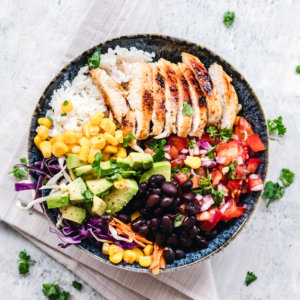
With so much information widely available about nutrition, it is easy to get confused about what is fact vs fiction. In this article, Registered Dietitian Sarah Scherer shares some common nutrition myths and the truth behind each of them.
Common myth 1: Vegetables and fruits in the produce section are always better than frozen.
This is a common myth we often think about in the winter or early spring months. This time of year, the produce section isn’t looking very fresh and the choices are more expensive. The truth is that vegetables and fruits are most nutritious when vine-ripened and freshly picked. “Vine-ripened” means they weren’t picked until they ripened on the plant, boosting their nutrition value, and “fresh” means they haven’t lost nutrients due to time in transit, temperature changes from being refrigerated, etc. So, come winter and spring, a lot of vegetables and fruits in our grocery stores aren’t vine-ripened or fresh. Here’s my recommendation: Choose frozen if the food is out of season and fresh if it is in season. You can find great information online about which vegetables and fruits are in season.
Common myth 2: Eating carbohydrates causes weight gain.
Current trends are all about a low-carb diet or the keto diet. Because these newer diets are focused on carbohydrate elimination for weight loss, many people believe that carbohydrates alone cause weight gain. But simply eliminating carbs is not the magic solution for weight loss. In fact, carbohydrates are an essential macronutrient for a well-functioning body. When eating carbohydrates, the complexity and portion size of the carbohydrates are the key. Whole grains or vegetable carbs such as legumes, beans, and peas are complex carbohydrates that will fill you up with fiber so you feel more full. My recommendation is to choose 50% or more of your carbohydrates as whole grains or vegetable-source carbs and limit these to ¼ of your plate. If you do this, you will be fueling your metabolism.
Common myth 3: Food nutrients are better than the supplement form.
This myth comes from the idea of bioavailability. It is true that some nutrients are better absorbed when they are combined with the enzymes that naturally exist in the same foods as the nutrients. But other nutrients are more readily eliminated through digestion and actually are better absorbed when in supplement form. Also, eating the average healthy diet can or having certain food preferences can sometimes still lead to nutrient deficiencies. My recommendation is to eat a diet full of colorful vegetables and fruits and take a multivitamin (preferably with a meal) so you are getting the best of both worlds. The Shaklee Life-Strip® and Vitalizer™ are my two favorite multivitamins.
Common myth 4: Eating 4–6 small meals instead of 3 leads to weight loss.
I have worked with many clients who swear that eating smaller meals more often is the “only way to lose weight,” but that might not be right for you. I make the recommendation to either eat smaller meals more often or 3 meals per day based on each person’s eating style. Here’s why. When it comes to the calorie math of weight loss, eating more often does increase the calories that are burned through the “thermic effect of food” (the energy burned to digest, absorb, and store food), but that calorie difference is minimal. Without other nutrition changes, simply eating the same number of total calories but spreading them throughout the day will not lead to weight loss. I recommend that if you are a person who needs to “feel full” to be satisfied after a meal, then eat 3 balanced meals per day. If you are a person who gets “snacky,” then eat 4–6 small, balanced meals per day. Depending on the type of eater you are, either choice may work for you. To lose weight, eat balanced meals that have fewer calories than your energy burn. It’s that simple.
Common myth 5: You MUST eat protein after a workout.
There are many opinions on the best post-workout fuel. To give you some background, there are three macronutrient calorie sources: protein, carbohydrates, and fats. During a workout, our bodies will first use carbohydrate stores because they are the quickest source of fuel. But we are also working muscles during exercise, resulting in muscle cell breakdown that the body will have to repair with protein. Calories from fat will be used last in most workouts. With these facts in mind, protein and carbohydrates are both beneficial for your post-workout fuel. My recommendation is to choose a post-workout fuel that has both protein and carbohydrates and fuel immediately after exercising. If your workout is focused on muscle building, then fuel with more protein. If your workout is focused on cardio training, then fuel with more carbohydrates. Check out the Shaklee Performance® Sports Nutrition line for the optimum workout fuel.
 Sarah Elijah Scherer, Shaklee Pure Performance Team Dietitian/Nutritionist
Sarah Elijah Scherer, Shaklee Pure Performance Team Dietitian/Nutritionist
As a two-time Team USA Olympian and Olympic finalist, Sarah has a passion for motivating and inspiring people to become the best version of themselves. In addition to her athletic career, her credentials as a Registered Dietitian, Licensed Nutritionist, and an MBA specializing in Healthcare Management enable her to help others achieve their goals. She has coached over one thousand individuals, focusing on weight loss, improved sports performance, diabetes prevention, heart health, healthy aging, smoking cessation, and additional healthy lifestyle and performance goals.





